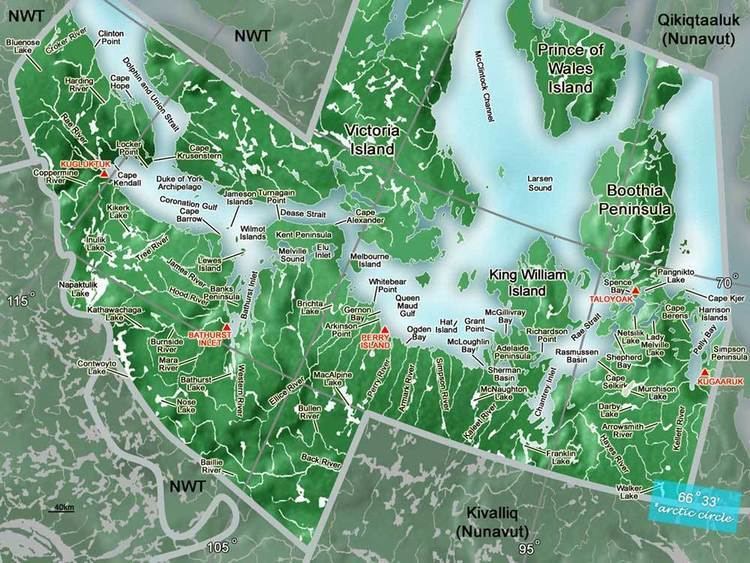 | ||
Kitikmeot Region (Inuktitut: Qitirmiut ᕿᑎᕐᒥᐅᑦ) is an administrative region of Nunavut, Canada. It consists of the southern and eastern parts of Victoria Island with the adjacent part of the mainland as far as the Boothia Peninsula, together with King William Island and the southern portion of Prince of Wales Island. The regional seat is Cambridge Bay (population 1,766;).
Contents
Map of Kitikmeot Region, NU, Canada
Before 1999, Kitikmeot Region existed under slightly different boundaries as Kitikmeot Region, Northwest Territories.
Transportation
Access to the territorial capital of Iqaluit is difficult and expensive as there are no direct flights from any community in the region. For example, Iqaluit is approximately 1,069 km (664 mi) from Kugaaruk, the closest Kitikmeot community. A one way flight to the capital costs between $2,691 and $2,911 (as of November 2016) and involves flying to, along with an overnight stay in, Yellowknife, Northwest Territories, approximately 1,310 km (810 mi) southwest of Kugaaruk. In total a trip of about 3,627 km (2,254 mi).
Like the rest of Nunavut there is no road access to the region and all places are fly-in. All five hamlets have certified airports, Cambridge Bay Airport, Gjoa Haven Airport, Kugaaruk Airport, Kugluktuk Airport and Taloyoak Airport, with scheduled flights by Canadian North and First Air.
There are also five registered aerodromes in the region. Cambridge Bay Water Aerodrome is a floatplane base open in the summer only. Doris Lake Aerodrome, a 7,894 ft (2,406 m) ice runway, the longest in the region which serves the Doris Lake mine. George Lake Aerodrome, an ice runway, like Doris Lake is only open from January to April, and serves the Back River Gold Project. Goose Lake Aerodrome also serves the Back River Gold Project and has both an ice and gravel runway. Hope Bay Aerodrome serves the Hope Bay mine site and is a gravel runway. None of the aerodromes have scheduled flights and are charter only. Bathurst Inlet and Umingmaktok have landing strips and no scheduled flights. Seaplanes may land there in the summer.
In the late summer the region is resupplied by barges and container ships from three companies, Desgagnés Transarctik and Nunavut Eastern Arctic Sealink (NEAS) from the east and the Northern Transportation Company (NTCL) from the west. The region forms part of the Northwest Passage and has hosted several cruise ships, the largest of which was the Crystal Serenity in 2016. Although the waterways are open in the summer there are no scheduled general passenger ships and only private yachts, such as the Octopus owned by Paul Allen, and cruise ships pass through.
Politics
The region is home to the only two communities in Nunavut that voted "no" in the 1982 division plebiscite: Cambridge Bay and Kugluktuk.
The region has four electoral districts;
Former districts include Akulliq, which covered Kugaaruk and Naujaat in the Kivalliq Region. It was the ony electoral district in Nunavut to cross two regions. Nattilik, which covered Gjoa Haven and Taloyoak. The previous incumbent was the former federal Minister of Health, Leona Aglukkaq.
In 2007 at their AGM, Bob Lyall, a board member of the Kitikmeot Inuit Association, suggested the formation of a political party called the Bloc Kitikmeot to run in the next general election and to advocate for a separate Kitikmeot Territory. Bobby Lyall, along with his brother Kitikmeot Corporation president, Charlie Lyall and delegates Martina and Connie Kapolak, argued that the Government of Nunavut had spent most of the infrastructure money available from the federal government in the Baffin Region (Qikiqtaaluk Region). However, the party was not formed and consequently no members ran for a seat in the Legislative Assembly of Nunavut which continues to run as a consensus government.
Communities
Hamlets
Other
Demographics
The Kitikmeot Region also doubles as one of three census divisions in Nunavut, the others being the Kivalliq (also known as the Keewatin) and the Qikiqtaaluk (also known as the Baffin) regions. Of the three the Kitikmeot is the smallest in size being 1,343.8 km2 (518.8 sq mi) smaller than the Kivalliq. It has the smallest population and is the least densely populated of the three. The population is predominantly Inuit (90.0%) with 0.7% other aboriginal peoples, 0.3% North American Indian and 0.4% Métis, and 9.3% non-Aboriginals.
Canada 2016 Census
